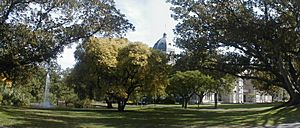Carlton Gardens facts for kids
| UNESCO World Heritage Site | |
|---|---|

Aerial view of The Royal Exhibition Building in the Carlton Gardens and the Melbourne City Centre
|
|
| Location | Central Business District, Carlton, Melbourne, Victoria, Australia |
| Part of | Royal Exhibition Building and Carlton Gardens |
| Criteria | Cultural: (ii) |
| Inscription | 2004 (28th Session) |
| Extensions | 2010 |
The Carlton Gardens is a beautiful World Heritage Site found on the edge of Melbourne, Australia. It's a popular place for picnics and barbecues. You can also spot some cool wildlife here, like brushtail possums!
This amazing park covers about 26 hectares (that's like 64 football fields!). It's home to the famous Royal Exhibition Building, the Melbourne Museum, and an Imax Cinema. You'll also find tennis courts and a fun children's playground. The gardens are surrounded by Victoria Street, Rathdowne Street, Carlton Street, and Nicholson Street.
The Royal Exhibition Building and Carlton Gardens are very important. They are recognized for their history, architecture, beauty, and even their special plants.
Contents
Exploring the Gardens
The Carlton Gardens are designed in a classic Victorian style. This means they have big open lawns and many different kinds of trees. You'll see trees from Europe like English oaks and plane trees. There are also Australian trees like Moreton Bay figs.
Paths lined with trees lead you around the park. They highlight beautiful fountains and the grand Exhibition Building. There's a special path called the grand allee made of plane trees. It leads right up to the Exhibition Building.
You'll find two small, pretty lakes in the southern part of the park. The northern part has the museum, tennis courts, and the children's playground. This playground is designed like a Victorian maze, which is super fun!
Amazing Plants and Trees
The gardens are special because they have an amazing collection of plants. Many of these trees have grown very large and have unique shapes. Some of the elm trees here are rare. They are important because many similar trees worldwide were lost to a disease called Dutch elm disease.
The gardens also have some very rare plants. For example, there's a type of tree called Acmena ingens. Only a few others are known to exist! There's also a huge Taxodium distichum, which is the biggest one recorded in Victoria.
Wildlife You Might See
The Carlton Gardens are home to many animals. You might see brushtail possums climbing in the trees. In spring, you can spot ducks and their ducklings in the lakes. Look up and you might see tawny frogmouths or kookaburras.
Common birds like Indian mynas and silver gulls are always around. At night, special bats like Gould's wattled bat hunt for insects. Grey-headed flying foxes also visit when native trees are flowering or have fruit.
Beautiful Fountains
There are three important fountains in the gardens. The Exhibition Fountain was made for the 1880 Exhibition by a sculptor named Joseph Hochgurtel. There's also the French Fountain and the Westgarth Drinking Fountain. They add to the beauty of the park.
Past Sports Events
The area north of the Exhibition Building used to be a sports ground. It was known as the Exhibition Oval. In the past, it had tracks for cycling races and even motorcycle races. These races were popular until the 1930s.
The grass area in the middle was used for different sports and events. Today, the gardens, including the Exhibition Building and its fountains, are a very popular place for wedding photos.
History of Carlton Gardens
The Carlton Gardens have a long and interesting history:
- 1839 – Large areas of land around Melbourne were set aside. The Carlton Gardens were one of these special public parks.
- Around 1856 – The City of Melbourne took control of the gardens. They hired Edward La Trobe Bateman to design the park.
- 1870s – The government took over the gardens again. They made changes for the 1880 Melbourne International Exhibition.
- 1880 – The Exhibition Building was finished for the Melbourne International Exhibition.
- 1888 – The Melbourne Centennial Exhibition was held here. It celebrated 100 years since European settlement in Australia.
- 1901 – The first Parliament of Australia met in the Exhibition Building.
- 1919 – During an influenza epidemic, the buildings became an emergency hospital.
- Second World War – The buildings were used by the RAAF.
- 1948 to 1961 – Part of the complex helped new migrants settle in Australia.
- 1999 – The Melbourne Museum opened in the gardens.
- 2001 – A new children's playground was designed and built. It won an award for its creative and respectful design.
- July 2004 – The Royal Exhibition Building and Carlton Gardens were added to the World Heritage List. This means they are recognized as very important to the whole world.
The Exhibition Building is still used for events today. One popular event is the annual Melbourne International Flower and Garden Show.
Images for kids
See also
 In Spanish: Jardines Carlton para niños
In Spanish: Jardines Carlton para niños










